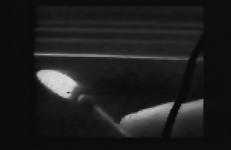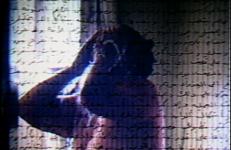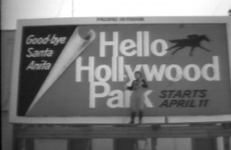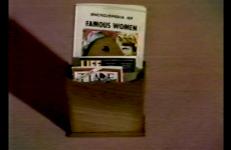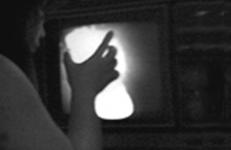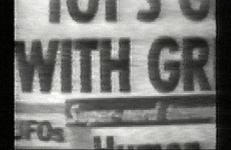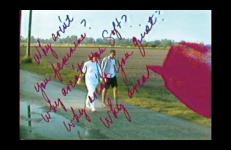Through a catalogue of looks, movements, and gestures, Mayhem presents a social order run amok in a libidinous retracing of film noir conventions. Sexuality flows in an atmosphere of sexual tension, danger, violence, and glamour; antagonism between the sexes is symbolized in the costuming of women in polka dots and men in stripes. Censored in Tokyo for its use of Japanese lesbian erotica, this tape creates an image bank of what signifies the sexual and the seductive in the history of imagemaking, pointing to the way we learn about our bodies, and how to use them from images.
Feminism
Based on a novel by Rita Mae Brown, Me and Rubyfruit chronicles the enchantment of teenage lesbian love against a backdrop of pornographic images and phone sex ads. Benning portrays the innocence of female romance and the taboo prospect of female marriage.
This title is also available on Sadie Benning Videoworks: Volume 1.
In this video, the artist tries to overcome the effects of distance, and reflects on geography represented in exile due to war, and on the psychological distance represented in each one’s approach to her womanhood. The video beautifully weaves personal images and audio recordings of a very intimate nature, binding the personal with the political.
Performance artist/sculptor Ana Mendieta used the raw materials of nature: water, mud, fire, rock, and grass. The consciousness of her politics and the poetics of her expression fill her work with an emotionally charged vision that is powerfully conveyed in this posthumous video profile. Drawing upon the raw spiritual power of Afro-Cuban religion, Mendieta used her art as a ritualistic and symbolic activity to celebrate the forces of life and the continuum of change.
Performance artist/sculptor Ana Mendieta used the raw materials of nature: water, mud, fire, rock, and grass. The consciousness of her politics and the poetics of her expression fill her work with an emotionally charged vision that is powerfully conveyed in this posthumous video profile. Drawing upon the raw spiritual power of Afro-Cuban religion, Mendieta used her art as a ritualistic and symbolic activity to celebrate the forces of life and the continuum of change.
Child masterfully composes a rhythmic collage of symmetries and asymmetries in a fluid essay that forefronts the treatment of the body as a mechanized instrument — placing the body in relation to the man-made landscape of factories, amusement parks and urban office complexes. Vocals performed by Shelley Hirsch.
An interactive CD-ROM inspired by the lives and work of ten famous women: Josephine Baker, Simone de Beauvoir, Catherine the Great, Colette, Marie Curie, Marlene Deitrich, Isadora Duncan, Frida Kahlo, Margaret Mead, and Gertrude Stein. The CD-ROM is an investigation into the intersecting economies of sexuality, authorship, eroticism, and gender that inform the lives of women. Their identities are configured in the negotiated space between self and other, a negotiation that continues in Tamblyn's relationship to them as narrator.
Originally presented as a live performance piece using actors, multiple monitors, and music, Modern Times is a consolidation of seven short chapters in the life of a modern woman. In the first sequence, the objects in a suburban home are inventoried: "nice couch," "nice car," and so on — ending with the titles "nice concept," "nice image" — and unmasking this materialistic world as an impossible consumer fantasy. In the next scene, an attractive man sunbathes.
Looking like a 1970’s version of “Rosie the Riveter”, Mogul takes on the persona of an artist who makes a living posting billboards on the Sunset Strip in Hollywood. As Mogul recounts her climb up the billboard “ladder”, she realizes that the only way to truly make a “name” for herself is to create her own billboard. And so she does.
The artist's mother comments about the status of women while reading a doll house sized book titled Encyclopedia of Famous Women.
Segalove takes her mom as subject in these short pieces, recording her stories, her advice, and her daily routine. What results is a portrait of a contemporary mother-daughter relationship, touchingly devoid of drama and full of whimsical humor. For example, in one piece, Ilene’s mother laments over a pair of shoes her daughter has chosen to hang on the wall instead of wearing, saying,”With you, everything is art.” In another segment the camera focuses on a pair of unoccupied, overstuffed chairs.
Part bio, part memoir, Mom’s Move is an intergenerational film about mothers and daughters, women and photography, remembering and forgetting, and the tension between women’s private and public selves.
Rhoda Mogul, housewife and mother of six, was a lifelong avid amateur photographer. Her creative drive – though confined to the home – had a major influence on my public life as an artist and filmmaker.
A video collage that chronicles the issues and events that arose in Linda M. Montano’s life while she devoted a year to each of the seven chakras. Beginning as a piece devoted to themes of commitment and limitation, the work becomes a fascinating hybrid of art and life, as Montano experiences the onset of menopause, her mother’s death, her choice to enter and then leave a convent, the suffering of a stroke, and thoughts of her own death—all within the structural confines of an intense work of art.
My Failure to Assimilate muses on the profound sense of melancholy that sets in after the end of a relationship. The tape uses poetry, songs, collage, interviews, and narrative elements to construct a complex picture of the resulting loss of direction and loss of identity. The tape is organized into three sections: Part 1: 'Schizophrenia'; Part II: 'Alienation'; and Part III: 'True Self'. Central to the question of identity is the interplay between imaginary and symbolic identification.
—Maria Troy and Thompson Owen
In this classic personal elegy, Kubota mourns her father's death and recounts the last days of his life. Reflecting on Kubota's use of the video medium, the television emerges as the link between Kubota and her father, with the melodramatic crooning of Japanese pop singers providing a backdrop for Kubota's real-life tragedy.
This title is also available on Surveying the First Decade: Volume 1.
My Mother’s Place is an experimental documentary focusing on the artist’s mother, a third-generation Chinese-Trinidadian who at 80 still has vivid memories of a history lost or quickly disappearing. She conveys these with a storytelling style and a frankness that is distinctly West Indian. A tape about memory, oral history, and autobiography, My Mother’s Place interweaves interviews, personal narrative, home movies, and verité footage of the Caribbean to explore the formation of race, class, and gender under colonialism.
Segalove re-enacts the trials and travails of her desperate, hormonal, pubescent years with actors dancing their way through what looks like a techni-color version of the Cleaver’s backyard. She plays herself, getting questionable advice from girlfriends, begging her mother for a bra and falling in love for the first time, with Moondoggie in Gidget Goes Hawaiian.
In this interview, American writer, artist, performer Eileen Myles (b.1949) discusses the various philosophies that motivate her work, including the language of film, embodied performance, and the alienation evoked by bodily vulgarity. Myles links her wide range of artistic and literary practice with notions of abstraction, improvisation, and the mythology of gender, which she explores in relation to her own identity as a working, middle-class lesbian woman. She reflects on the significance of geographical locations, both New York City and San Diego, on her art, and shares how her past struggles with addiction have shaped her life and practice.
In New Report, Wynne Greenwood and K8 Hardy are reporters at WKRH - the feminist news station that is "pregnant with information." As Henry Irigaray (Hardy) and Henry Stein-Acker-Hill (Greenwood), these two lesbian feminist artists stage reports on and with their friends, their social herstories, their nerves, and their bodies. It is urgently broadcast live to the newsroom and out to their studio audience.
In New Report, Wynne Greenwood and K8 Hardy are reporters at WKRH - the feminist news station that is "pregnant with information." As Henry Irigaray (Hardy) and Henry Stein-Acker-Hill (Greenwood), these two lesbian feminist artists stage reports on and with their friends, their social herstories, their nerves, and their bodies. It is urgently broadcast live to the newsroom and out to their studio audience.
The second installment of the collaborative project New Report, an ongoing series of performances and videos, Artist Unknown features K8 Hardy (founder of the queer feminist art collective LTTR) and Wynne Greenwood (of Tracy and the Plastics) playing Henry Irigaray and Henry Stein-Acker-Hill, and anchor and roving correspondent for WKRH, a feminist TV news station whose tagline is "pregnant with information." Based on documentation of a live, digital communication in real time between Greenwood at Foxy Production Gallery and Hardy on the street in New York.
The second installment of the collaborative project New Report, an ongoing series of performances and videos, Artist Unknown features K8 Hardy (founder of the queer feminist art collective LTTR) and Wynne Greenwood (of Tracy and the Plastics) playing Henry Irigaray and Henry Stein-Acker-Hill, and anchor and roving correspondent for WKRH, a feminist TV news station whose tagline is "pregnant with information." Based on documentation of a live, digital communication in real time between Greenwood at Foxy Production Gallery and Hardy on the street in New York.
In a version of the “teenage diary,” Benning places her feelings of confusion and depression alongside grisly tales from tabloid headlines and brutal events in her neighborhood. The difficulty of finding a positive identity for oneself in a world filled with violence is starkly revealed by Benning’s youthful but already despairing voice.
This title is also available on Sadie Benning Videoworks: Volume 1.
No More Nice Girls layers the personal and political histories of women active in the 1970s feminist art movement, including Brenda Starr, Yvonne Rainier, B. Ruby Rich, Carrie Mae Weems, and Sherry Millner. Set in the mid-1980s, when many of the advances of the women’s movement were threatened by backlash conservatism, this video forefronts conversations between feminists over a collage of archival photographs, newspaper headlines, and bumper stickers that recollect a feminist history in danger of erasure.
" … Brilliantly written and realized”
NOMADS at the 25 DOOR is presented in three chapters and based around a series of interviews between Finley and Mickey Yates, a 22-year-old woman serving a double life sentence in the Nevada Women’s Correctional Institution for the murder of her mother. Interweaving interview excerpts with footage of the upheaval in Eastern Europe, the tape explores the memory’s construction of an ephemeral homeland when a concrete one is lost, stolen or left behind.





